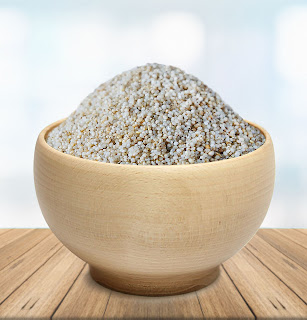Rice
1.Kodo Millet - Varagu Rice
Kodo Millet, also known as Varagu Rice or kodra in hindi, has been grown and consumed in the southern part of India for centuries.Millets are a group of highly variable small-seeded grasses, widely grown around the world as cereal crops/grains. Millets are also unique due to their short growing season. They can develop from planted seeds to mature, ready to harvest plants in as little as 65 days. The two reasons to eat millets are nutritional and environmental. Compared to rice, especially polished rice, millets release lesser glucose and over a longer period of time.This lowers the risk of diabetes. Being gluten-free, they are also suitable for people with gluten intolerance/celiac disease. By eating millets, we will be encouraging farmers in dry landareas to grow crops that are best suited for those regions. This is a step towards sustainable cropping practices and bio-diversity. Kodo millet is a versatile ingredient and can be cooked like rice or used in recipes as a rice alternate.It can also be used to make porridge,upma,dhoklas,idlis and a falafel of sorts with the addition of tofu and vegetables. It can also serve as a salad base.
Kodo millet (Paspalum scrobiculatum) is an indigenous cereal or millet in varied tropical regions. Kodo can be cultivated in extreme dry and drought lands and stony soils as well as saline lands. It is also known as kodra, varagu, arikelu, harka, and kodoa. Kodo or varagu is a popular fast or upvas food in some parts of India. The millet is definitely superior to rice, gluten free and rich in fibre, vitamins and minerals.
Nutrient content:
Kodo has good protein content (11%), its low in fat (4.2%) and very high in fibre content (14.3%). Some varieties of kodo millet were found to contain 37 to 38% dietary fibre which is highest among cereals. It contains a high amount of lecithin that helps to strengthen the nervous system. It is rich in B vitamins especially niacin, B6 and folic acid, and contains minerals like calcium, iron, potassium, magnesium and zinc
Health Benefits of Kodo millet
- Anti-diabetic
- Antioxidant and anti-microbial activity
- Anti-obesity
- Anti-cholesterol and anti-hypertension

Proso millet is a unique Indian Millet that is commonly known as white millet, Kashif millet or hog millet. It is a wild grass species that was domesticated as a crop somewhere around 7000 years ago, in China. This millet is now cultivated in India, the Middle East, Turkey, Russia and the United States. In the United State, Proso millet is mainly grown for birdseed. It is sold as health food, and due to its lack of gluten, it can be included in the diets of people who cannot tolerate wheat.
roso millet, compared to other food grains, has the lowest water requirement for any cereal. It is an excellent crop that can easily grow in arid conditions and rain shadowed regions. Proso millet is sold as a health food due to lack of gluten and can be incorporated into the diets of people who are wheat intolerant.
Why is Proso Millet unique?
Proso Millet is nutritious and delicious. It has somewhat of an egg-shaped fertile floret and its hull is hard and shiny and firmly encloses the seeds when it is shed. It comes in various colors, from brownish black through olive brown, orange-red, golden and light cream.
The bran of Proso millet contains vital nutrients that are essential for a healthy diet and is also an excellent source of fiber! It is gluten-free and has a significant amount of carbohydrates, protein, niacin (Vitamin B3) and fatty acids. Apart from these nutrients, it also contains essential minerals like phosphorus, manganese, and magnesium.
What is Barnyard Millet?
The Barnyard millet (Echinochloa frumantacea) is a wild seed and not a grain, mainly grown in the hilly areas of Uttaranchal, India. The barnyard millet is the fastest growing crop, which can produce ripe grains within 45 days from the sowing time under optimal weather conditions. The other names of barnyard millet are shyama in Bengali, moraiyo in Gujarati, sanwa in Hindi, oodalu in Kannada, kuthiraivolly in Tamil and udalu in Telugu.
The barnyard millet is a wholesome grain over and above common cereal grains like rice, wheat, semolina (rawa) and by no means should be restricted to just the fasting days. It holds benefits rendered by millet grains, is easily available across India, is highly economical and makes a tasteful food for all age groups. Varied food preparations can be made in a jiffy with the tiny wonder grain. Barnyard millet is nature’s gift to the modern diet and sedentary activities that can lead to lifestyle disorders.
Health Benefits of Barnyard Millet
1. Low in Calories
2. Rich in Fiber
3. Low Glycemic Index
4. Gluten-Free Food
5. Good Source of Iron




Comments
Post a Comment